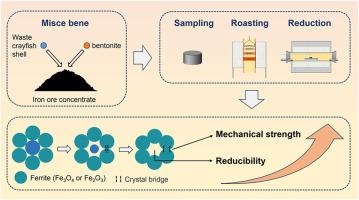废小龙虾壳的加入提高了赤铁矿型煤的机械强度和还原性
IF 5.8
2区 生物学
Q1 AGRICULTURAL ENGINEERING
引用次数: 0
摘要
随着环境压力的增加,能源密集型的炼铁行业正在寻找替代方案,以减少对焦炭的依赖,废弃的小龙虾壳(在中国储量丰富)作为碳中性燃料提供了一个很有前途的解决方案。通过焙烧和还原试验,研究了废小龙虾壳作为添加剂对赤铁矿型煤性能的影响及其机理。结果表明,添加WCS可显著提高烧成型煤的抗压强度,但还原度略有提高。与膨润土混合后,成型煤在干燥和预热阶段的强度均有显著提高,同时其还原膨胀性也有所提高。原位红外光谱和扫描电镜显示,WCS在热处理过程中释放出含有多种成分的气体,导致体积逐渐缩小,并在原始位置形成孔洞。这种持续的气体释放延长了磁铁矿氧化为晶格结构完整的赤铁矿的过程,直接延长了颗粒间晶桥发育的时间,从而提高了抗压强度。此外,形成的孔隙有利于还原性气体的扩散,从而提高了成型煤的还原性。该研究也为在氧化球团生产中利用类似WCS的阶段性气体释放材料提供了参考。本文章由计算机程序翻译,如有差异,请以英文原文为准。

Waste crayfish shell addition improves mechanical strength and reducibility of hematite briquettes
With increasing environmental pressures, the energy-intensive ironmaking industry is seeking alternatives to reduce coke dependency, with waste crayfish shell (abundant in China) offering a promising solution as a carbon-neutral fuel. This study investigated the effects and mechanisms of using waste crayfish shells (WCS) as an additive on the performance of hematite briquettes through roasting and reduction experiments. The results indicated that adding WCS significantly increased the compressive strength of the fired briquettes, with a slight improvement in reduction degree. When combined with bentonite, the briquettes showed significant improvements in strength during the drying and preheating stages, while the reduction swellability also improved. In-situ infrared spectroscopy and scanning electron microscopy revealed that WCS released gases containing various components during heat treatment, causing a gradual reduction in volume and the formation of holes at the original location. This sustained gas emission prolonged the oxidation process from magnetite to hematite with complete crystal lattice structure, which directly extended the time available for interparticle crystal bridge development, thereby enhancing compressive strength. Furthermore, the formed pores facilitated the diffusion of reducing gases, thus improving the reducibility of briquettes. This study also provides a reference for utilizing materials exhibiting staged gas release, similar to WCS, in oxidized pellet production.
求助全文
通过发布文献求助,成功后即可免费获取论文全文。
去求助
来源期刊

Biomass & Bioenergy
工程技术-能源与燃料
CiteScore
11.50
自引率
3.30%
发文量
258
审稿时长
60 days
期刊介绍:
Biomass & Bioenergy is an international journal publishing original research papers and short communications, review articles and case studies on biological resources, chemical and biological processes, and biomass products for new renewable sources of energy and materials.
The scope of the journal extends to the environmental, management and economic aspects of biomass and bioenergy.
Key areas covered by the journal:
• Biomass: sources, energy crop production processes, genetic improvements, composition. Please note that research on these biomass subjects must be linked directly to bioenergy generation.
• Biological Residues: residues/rests from agricultural production, forestry and plantations (palm, sugar etc), processing industries, and municipal sources (MSW). Papers on the use of biomass residues through innovative processes/technological novelty and/or consideration of feedstock/system sustainability (or unsustainability) are welcomed. However waste treatment processes and pollution control or mitigation which are only tangentially related to bioenergy are not in the scope of the journal, as they are more suited to publications in the environmental arena. Papers that describe conventional waste streams (ie well described in existing literature) that do not empirically address ''new'' added value from the process are not suitable for submission to the journal.
• Bioenergy Processes: fermentations, thermochemical conversions, liquid and gaseous fuels, and petrochemical substitutes
• Bioenergy Utilization: direct combustion, gasification, electricity production, chemical processes, and by-product remediation
• Biomass and the Environment: carbon cycle, the net energy efficiency of bioenergy systems, assessment of sustainability, and biodiversity issues.
 求助内容:
求助内容: 应助结果提醒方式:
应助结果提醒方式:


